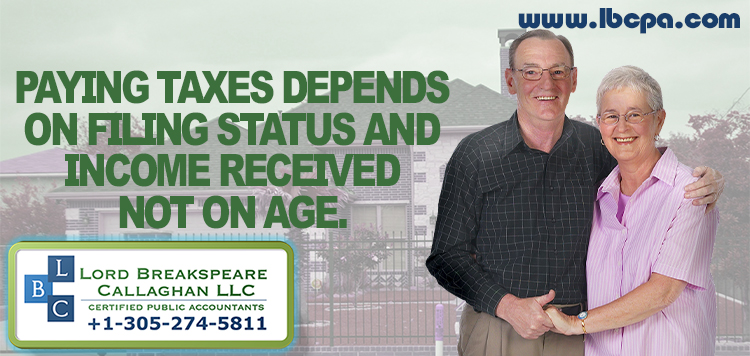LBCPA News 
Click here to go back
You’re Never Too Old to File a Return – Taxes and the Elderly

Taxpayers who are winding down full-time work may think that they can also wind down their tax return filing requirements. However, taxpayers are never too old to have a filing requirement. Although age is a consideration, filing requirements are determined by a variety of factors such as filing status, the type and amount of income received, and yes, even age. For 2021, single taxpayers are required to file a tax return if their gross income is $12,550 or more; however, single taxpayers 65 or older are not required to file unless their gross income is $14,250 or more.
Social Security and Railroad Retirement benefits
Many elderly taxpayers receive Social Security or Railroad Retirement benefits, both of which are based on prior earnings. The taxability of these benefits is not determined by age, but rather by filing status and the type and amount of other income received. TAS research shows that 98.4 percent of the 2020 tax returns filed by taxpayers 65 or older reported other income in addition to Social Security and Railroad Retirement benefits.
Even though Social Security and Railroad Retirement benefits are based on a taxpayer’s earned income, these benefits are not considered income for such refundable credits as the Earned Income Tax Credit (EITC). For tax year 2020, about four percent of the returns filed by taxpayers 65 and older reflected at least one exemption for a child – with nearly 97 percent of these taxpayers receiving Child Tax Credit. And for tax year 2020, 45 percent of the returns filed by taxpayers 65 or older reported pension or annuity income but reflected no income from wages. For many older taxpayers now raising their grandchildren, the option to claim EITC based on Social Security or Railroad Retirement benefits, or other retirement income based on a taxpayer’s earnings history, would further the credit’s goal of providing assistance to lower income families. This is especially true in multi-generational households, where raising children two or more generations removed may have been unplanned. In that vein, I have proposed legislative changes for restructuring and modernizing the EITC. Because the EITC is a credit for lower income families, its eligibility should more accurately reflect its target population.
Other credits may be available
Taxpayers 65 or older, and taxpayers under age 65 who receive taxable disability income due to being retired on permanent and total disability, may qualify for the Credit for the Elderly or Disabled. To be eligible for this credit, qualified individuals must also meet two income limitations: both their adjusted gross income and the total of their nontaxable Social Security and other nontaxable pensions, annuities, or disability income, must be below the designated amounts corresponding to the taxpayer’s filing status. If eligible, taxpayers should complete Schedule R, Credit for the Elderly or Disabled, and attach it to their tax return when filing. Taxpayers needing assistance to determine if they are eligible for this credit can use the IRS’s interactive tool, Do I Qualify for the Credit for the Elderly or Disabled?
Taxpayers paying a care provider to care for a spouse (or other qualifying relative) who was physically or mentally incapable of self-care so they could work or look for work should also consider their eligibility for the Child and Dependent Care Tax Credit. In 2021, the American Rescue Plan Act of 2021 (ARPA) temporarily increased this credit to provide additional help to working caregivers during the COVID-19 pandemic. For 2021 only, ARPA increased the limit on expenses that can be claimed to $8,000 for one qualifying person and $16,000 for two or more qualifying persons. The maximum credit amount was raised to 50 percent of employment-related expenses, which equals a maximum credit of $4,000 for one qualifying person or $8,000 for two or more qualifying persons. In addition, in 2021, the credit became potentially refundable for the first time.
Normally, a taxpayer (and spouse, if married filing jointly) must have “earned income” to qualify for the Child and Dependent Care Credit. Special earned income rules apply, however, for taxpayers and their spouses who are disabled. A disabled spouse is considered to have earnings of at least $250 for each month or part of a month they are unable to care for themselves. Therefore, disabled taxpayers, or taxpayers with a disabled spouse, may also benefit from this credit. Taxpayers who are uncertain regarding their eligibility for the Child and Dependent Care Credit may use the Interactive Child and Dependent Care Credit Eligibility Assistant on IRS.gov to determine eligibility.
If you have any questions regarding accounting, domestic taxation, essential business accounting, international taxation, IRS representation, U.S. tax implications of Real Estate transactions or financial statements, please give us a call at 305-274-5811.
Source: TAS






